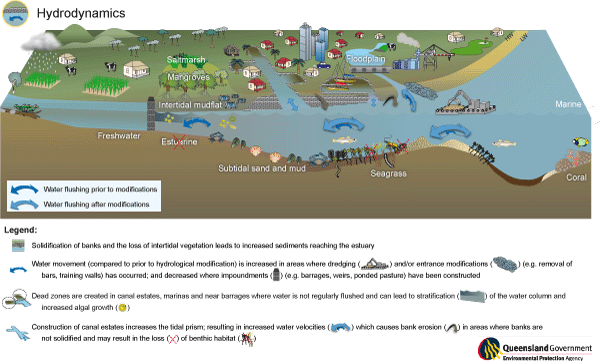Our current best conceptual understanding of the stressor ‘hydrodynamics’ is shown in Figure 1.
Figure 1. Potential causes of a change to hydrodynamics and the condition responses observed as a result of this change.
Physical modification of the lower reaches of an estuary, together with climatic change, can affect the local patterns of waves, currents or tidal exchange (i.e. hydrodynamic alterations). These alterations can contribute to the loss or degradation of habitat. Hydrodynamic modifications could include artificial closing or opening of entrances, breakwaters, canals, marinas, retention walls, training walls, levees, sea walls, spits, water barriers, artificial islands or reefs, and dredging, extraction or aquaculture structures. Impacts from changed hydrodynamics include changes to water depth, coastal currents, wave patterns, entrance opening pattern, turbidity, salinity, erosion and deposition patterns, erosion, eutrophication, algal blooms and loss of biota.
The most common, and often the most significant, impact on hydrodynamics results from dredging at the mouth of an estuary. In estuaries that are permanently open, dredging gives rise to incremental increases in tidal velocities, salinity and exchange rates. In coastal lagoons that are naturally cut off from the ocean, artificial opening of the entrance can have very large effects on salinity, which in turn significantly impacts on the nature of the biota present. At the other end of the scale, construction of barrages, canals or marinas can create areas of relatively poorly flushed water, and this reduction in exchange rates can have detrimental impacts on water quality and on biota, although this is by no means always the case. Increased canal area also increases the amount of water that occurs within the system as a whole. This water needs to be moved ‘out’ at low tide and ‘in’ at high tide. As the mouth of the estuary is the same as before the addition of the canals there is therefore an increased amount of water (i.e. flow) moving through the estuary and related consequences, e.g. increased erosion.



